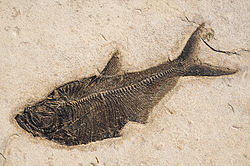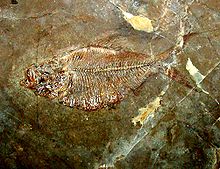- Diplomystus
-
Diplomystus
Temporal range: early Eocene, 55–34 Ma
Diplomystus from Eocene of Wyoming Scientific classification Kingdom: Animalia Phylum: Chordata Class: Actinopterygii Order: Clupeiformes Family: †Ellimmichthyidae Genus: Diplomystus
Cope, 1877Species: See text Diplomystus is an extinct genus of non-clupeoid clupeomorph fish distantly related to modern-day extant herrings, alewives, and sardines. The genus was first named and described by Edward Drinker Cope in 1877. There are four species of Diplomystus: Diplomystus dentatus (Cope, 1877), D. birdii, D. dubetreiti, and D. shengliensis (Chang 1983).
Diplomystus dentatus (Cope, 1877) is well known from lower Eocene deposits of the Green River Formation in Wyoming. Specimens range from larval size to 65 cm and are commonly found in close association with the extinct herring Knightia sp.
References
Bibliography
- Grande, Lance (1982). "A revision of the fossil genus Diplomystus : with comments on the interrelationships of clupeomorph fishes". American Museum Novitates (New York, New York, USA: American Museum of Natural History) 2728. hdl:2246/5342.
- Nelson, Gareth J. (1973). "Notes on the structure and relationships of certain Cretaceous and Eocene teleostean fishes". American Museum Novitates (New York, New York, USA: American Museum of Natural History) 2524. hdl:2246/2730.
- Zhang, Miman; John G. Maisey (2003). "Redescription of Ellimma branneri and Diplomystus shengliensis : and relationships of some basal clupeomorphs". American Museum Novitates (New York, New York, USA: American Museum of Natural History) 3404. hdl:2246/2830.
Categories:- Prehistoric bony fish
- Eocene fish
- Prehistoric fish of North America
Wikimedia Foundation. 2010.


